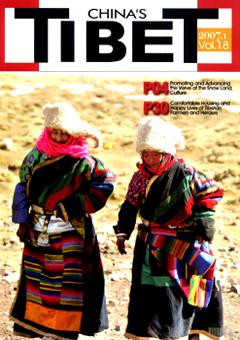PROMOTING AND ADVANCING THE VERVE OF THE SNOW LAND CULTURE
Liu Yandong
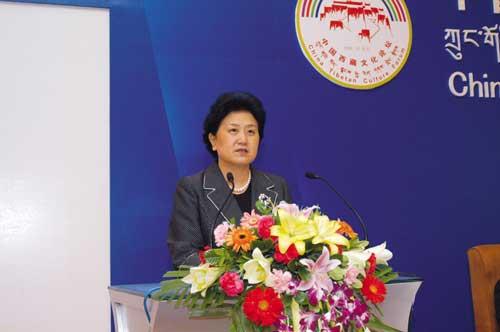
Madam Liu Yandong is delivering a speech at the first China Tibetan Culture Forum.Photo by Cheng Peng
The First China Tibetan Culture Forum is convened in the autumn of Beijing. Just as the ancient Chinese would express that it's always a pleasure to greet a friend from afar, I'd like to congratulate the convening of the forum on behalf of the Chinese Government and the Chinese People's Political Consultative Conference, welcome our guests from afar and express heartfelt gratitude to friends from both at home and aboard for your contribution made to the preservation and development of the Tibetan culture over the years!
China is a unified country of 56 ethnic nationalities. In her history, all nationalities have pooled their wisdom into the creation of a time-honoured and splendid Chinese culture and unique cultures of respective nationalities. Culture, as the spirit of a nation, serves as the basis of the very existence of the latter. The power of culture is forged into the vitality, creativity and cohesion of a nation. To understand a particular nation, one must understand its culture; likewise, to respect a nation, one must respect its culture. This forum, with the topic of "the preservation and development of Tibetan culture??, discusses the rich connotation and unique charm of the culture and urges its preservation and development. This pageant is therefore significant and of high profile and offers a chance for the gathering of people in the business, administration and the academic circles.
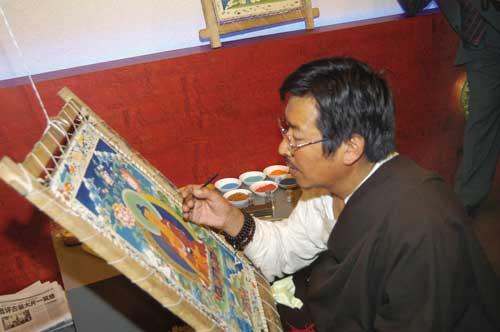
Tsewang Namgyal,the well-known artist,from Lhasa,is painting his Thangka.Photo by Cheng Peng
Tibet is a beautiful and endowed part of China; the Tibetan nationality is an important member of the family of the Chinese nation. For dozens of centuries, the diligent, kind, brave and resilient peoples of all nationalities in Tibet have lived on "the roof of the world, the snow land of the plateau"and created the splendid Tibetan culture which is a bright pearl in the treasure house of the Chinese culture and a rare blossom in the history of human civilizations. From the relics of Karub to the ubiquitous traits of ancient civilization, from the Potala Palace to numerous other architectures, from the Legend of King Gesar to folk literatures, from The Four Medical Tantras (Rgyud bzhi) to the miraculous Tibetan medicine and medication, from Tripitaka to the distinctive culture of Tibetan Buddhism, from the old Tibetan opera to exciting folk art forms...Tibetan culture is imbued in this sacred and pure piece of land, making "the apex of all mountains and origin of all waters"glow with magical radiance, enchanting the whole world.
Tibetan culture reflects the unique geographical scenery and social history of Tibet and carries the fruit of interaction between Tibet and civilizations of other nationalities. The entering into Tibet of Princess Wencheng, the assumption of the post of imperial tutor by Pagsba and the legendary encounters of peoples of various nationalities on the "Tea Horse Ancient Route"all reflect the path to development with joint efforts of Tibetan people and other brotherly nationalities, bear witness to the historical fact that since ancient times, Tibet has been an indivisible part of Chinese territory. Tibetan culture and other ethnic cultures of China construct the mental core of the Chinese culture, and build the spiritual great wall of the Chinese nation, and the former has made undeniable contribution to the social historical development of Tibet and the whole of the nation.
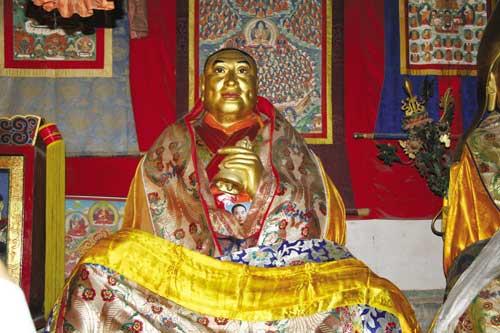
Gold-plating Status of the 10th Panchen Lama,preseved at Kumbum Monastery. Photo by Zhang Xiaoyu

Gilded & silver-palting Dharma wheel,a symbol of vivid wheel turning around forever
The Communist Party of China and the Chinese Government value greatly the preservation and development of Tibetan culture and usher in a new era of vigorous cultural development. It's been more than half a century since the peaceful liberation of Tibet. In its effort of propelling leapfrog social economic development in Tibet, the country formulated specialized policies, laws and regulations and invested greatly manpower, money and other material resources, inherit, protect and revitalize the fine cultural tradition of Tibet and its achievements have been witnessed by the whole world.
The country has always dedicated to the safeguard and protection of the rights of the Tibetan people in learning, using and developing their own language. All policies and legal documents of various levels of governments in the Tibet Autonomous Region, signs in various public places and radio and TV broadcasting, newspapers and magazines are all using both Tibetan and Mandarin. Lessons are basically taught in both languages in universities, middle schools and primary schools in Tibet. The Tibetan language is applied extensively in all sectors of social life and advancement has been made in the standardization of the language making the cornerstone of Tibetan culture even more solid.
The state has always dedicated to the preservation of cultural and historical relics in Tibet. Having provided huge funding, the state has helped to restore and reopen over 1,700 temples and monasteries, protected legions of valuable relics. Particularly since the 1980s, the state has appropriated nearly 700 million Yuan to renovate the Potala Palace, Norbulingka, the Sakya Monastery and the Jokhang Temple. The importance the country has attached to it, the amount of investment and the technology content are all unparalleled in the history of culture preservation in China and even in the world. This "miracle in the history of ancient architecture preservation"lets the ancient civilization gain new vigor.
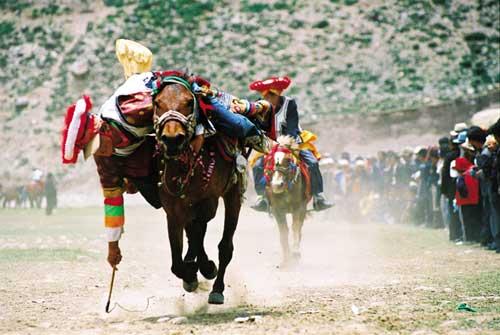
Tibetan Traditional Sports:pick up Hada.Photo by Gan Zhanglin
The country has always dedicated to respecting and preserving the folk customs and freedom of religious belief of various nationalities of Tibetan people who have both unique traditions in garments, gastronomy, housing and protocol as well as modern fashion with the trend of the times and who celebrate both traditional festivals of New Year in the Tibetan calendar, the Shoton Festival and Ongkor Festival as well as national and international festivals like Women's Day, Labors' Day, Children's Day and National Day. Modern civilization and traditional Tibetan culture drew upon the strengths of each other to demonstrate the endless charm of Tibetan culture.
The country has always dedicated to comprehensively inheriting and developing the Tibetan culture and art. The central government has helped to rescue and file tens and millions of words of materials in both Tibetan and Chinese. In particular, the collection and publication of the epic King Gesar has systematized the comprehensive work of literature that used to remain orally transmitted among the grassroots. Meanwhile, the modern culture and art undertakings in Tibet have also demonstrated a momentum with the creation of a large swathe of modern literary and artistic works with ethnic style and the pulses of the times, the establishment of a number of art galleries and exhibition halls and a variety of artistic and sports activities.
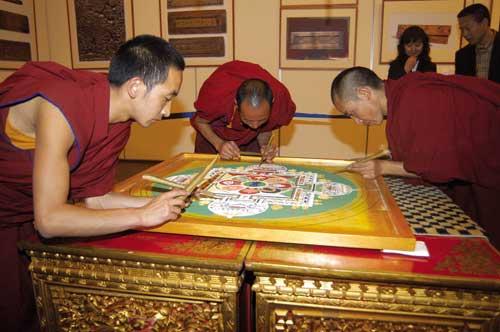
Making Mandala by monks from Tashilhunpo Monastery.Photo by Cheng Peng
The world changes as the times elapse. With the development of social economic undertakings in Tibet, traditional culture has been given sound protection and revitalization, and socialist new culture has been forcefully developed showing an unprecedented prosperity. Nowadays, Tibetan culture has bid farewell to its history of being monopolized by a few feudal monks and aristocracy of a higher ranking and has become the spiritual wealth and cultural fruits enjoyed by all nationalities of Tibet. Nowadays, Tibetan culture has inherited tradition and absorbed new connotations of the times. It is the spiritual drive for the peoples of different ethnic groups in Tibet to seize the opportunity and accelerate development. Nowadays, Tibetan culture is being modernized and is open to the world. It is the bridge for strengthening connection and extending exchange between Tibetan people and other ethnic peoples. It's been proved that Chinese Government protects and develops Tibetan culture to meet the fundamental interests of people of all ethnic groups in Tibet and the fundamental interests of the Chinese nation. Tibetan culture discards the negative parts and retains the positive parts. It is embracing new momentum and demonstrating fresh and vigorous vitality.
Into the 21st century, Chinese people are dedicated to the building of a socialist harmonious society and a harmonious world of lasting peace and common prosperity. A harmonious society and a harmonious world call for harmoniously coexisting cultures. Facing modernization, facing the world and facing the future, we will develop the fine tradition of the Chinese culture, absorb the strengths of the cultures of all nationalities of the world and build an advanced socialist culture with Chinese characteristics. Such a culture is a national culture. Persistence in the characters and spiritual ethnics of the Chinese nation is rooted in the five thousand years of our history as well as the practice of building socialism with Chinese characteristics. Such a culture is a scientific culture. It is guided by a scientific theory, discarding all eroded and backward values. It aims at enhancing comprehensively the moral quality and scientific and cultural establishments of the whole nation. Such a culture is a popular culture with people orientation and targets satisfying the multi-level and multi-layer spiritual demand of peoples of different ethnic groups. Such a culture is an open culture. It allows all cultures to exchange and learn from each other. It draws upon the strengths of others, expels the old and takes in the new. Such a culture is a harmonious culture that insists that all cultures should coexist harmoniously, be tolerant to each other, develop with the premises of respecting diversity and prosper in complementarity.
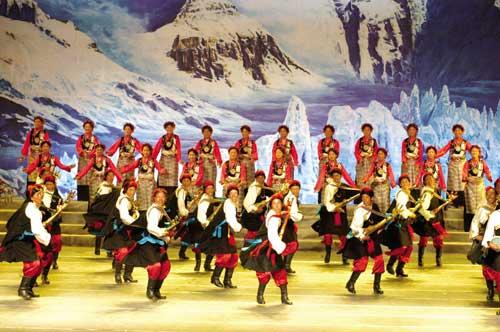
Performance team of farmers from Lhatse.Photo by Zhang Xiaoyu
The preservation and development of Tibetan culture is an important part of building an advanced socialist culture with Chinese characteristics and an unshirkable responsibility of the Chinese government. We will always respect history, ground ourselves in reality, target at development, research on Tibetan culture, publicize extensively and develop the culture so that the protection and development of Tibetan culture can be loyal to history, to the times and to all Chinese people including the people of Tibet.
Respecting history is to respect the fine national cultural tradition and inherit and carry on the quintessence of Tibetan culture. A time-honoured and lively Tibetan culture benefits from its historical accumulation and the nourishment of national tradition. The protection and development of Tibetan culture need a further exploration of the precious historical cultural heritage of various ethnic groups in Tibet, a constant understanding and recognition of the rich content of its cultural tradition, a forceful drive for the research on the traditional Tibetan culture and a development of the fine traditional culture of Tibet.
Grounding ourselves in reality means relying on social practice and demonstrate the vigor of Tibetan culture. Culture originates from colourful social practices and will also facilitate the development of social practice. The preservation and development of Tibetan culture should be connected to the leapfrog economic and social development in Tibet, to the practice of building a well-off society and a socialist harmonious society, and to the practice of safeguarding national unity and the reunification of the motherland, promoting development, enhancing unity, realizing harmony and providing spiritual support while getting enriched and keeping vigor and vitality.
Targeting at development means promoting Chinese culture and facilitating the advancement of human civilization. Tibetan culture belongs to China as well as the world. The development of Tibetan culture is not only the illustration of the exchange between common development of Tibetan nationality and other nationalities of China, but also a process of complementarity between Tibet and cultures of other nations of the world. To preserve and develop Tibetan culture requires a tolerant attitude so as to upgrade the exchange and cooperation between the Tibetan culture and the cultures of other nationalities, inject new vitality into the development of Tibetan culture, add new colour to Chinese culture and make new contribution to the advancement of human civilization.
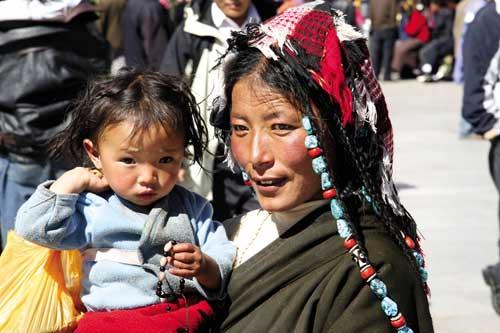
Mother and her daughter. Photo by Zhang Xiaoyu
Many international friendly personages have long been active in the social economic development of Tibet and the protection and publicity of Tibetan culture. All Chinese people including the Tibetan people will not forget that. We sincerely hope that you could show interest in and support the social economic development of Tibet and participate in the preservation and development process as you have always done so as to demonstrate an ancient, marvelous and splendid Tibetan culture of China in front of the world and to demonstrate a prosperous, harmonious and open Tibet of China in front of the world.
Culture is crystallized from history, and foretells what future holds for us. I believe with the protection of the family of the Chinese nation and the active participation and support of friends of the world, the Tibetan culture will be like the rivers and waters flowing uninterruptedly in the history of Chinese nation; will be like a precious piece of gem shedding glamour in the forests of Chinese culture and the cultures of the world. Here I'd like to quote the late Honorary President of China Association for the Preservation and Development of Tibetan Culture, the well-known social activist Mr. Fei Xiaotong to encourage the protection and development of Tibetan culture: "appreciate the beauty of one's own culture, appreciate the beauty of other ones, let the different beauties coexist and the world is thus a harmonious home to all."

